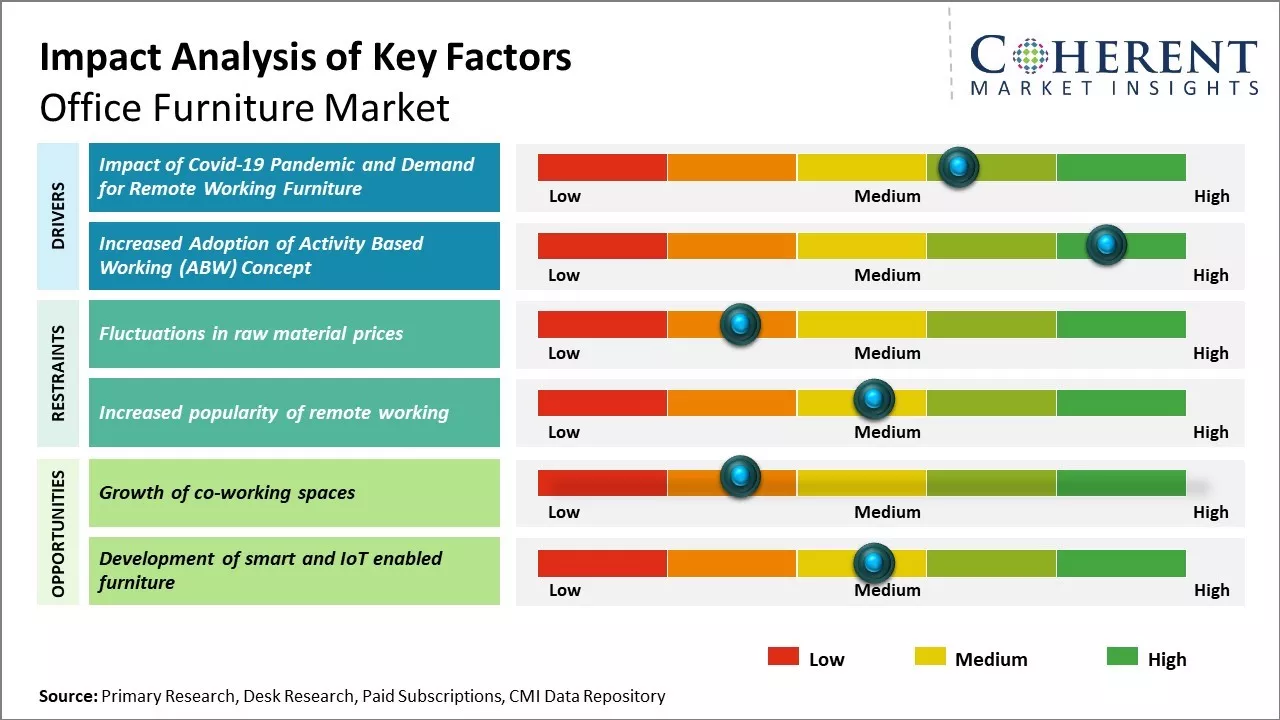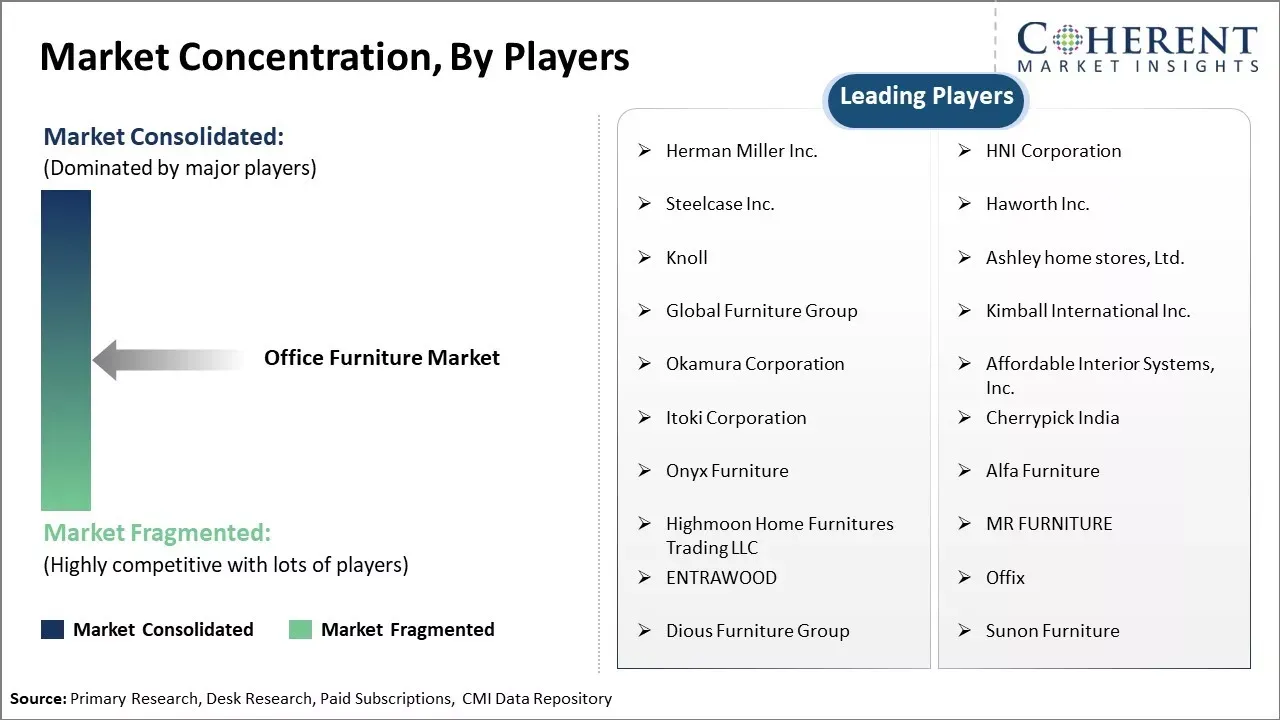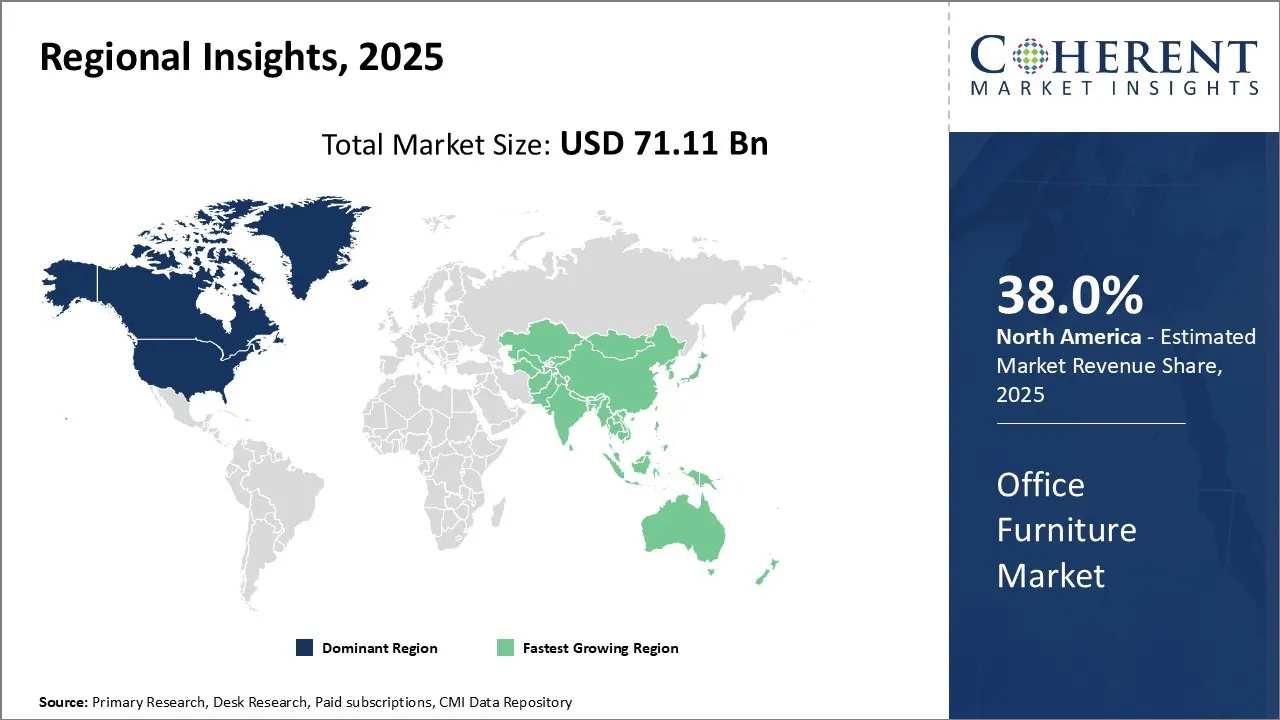The global office furniture market is estimated to be valued at USD 71.11 Bn in 2025 and is expected to reach USD 107.00 Bn by 2032, exhibiting a compound annual growth rate (CAGR) of 6.0% from 2025 to 2032.

To learn more about this report, Download Free Sample
The global office furniture market has been witnessing steady growth over the past few years. There is a rising demand for more flexible and automated furniture solutions that can adapt to the hybrid work models adopted by many organizations post-pandemic. Modular and sit-stand desks as well as storage cabinets on wheels are gaining more traction among office space designers. Sustainability also remains a key factor influencing purchasing decisions in this market. Many companies are investing in furniture made from recycled, recyclable, or remanufactured materials to reduce their environmental footprint.
|
Current Events |
Description and its impact |
|
Economic Pressures and Inflation |
|
|
Trade Policy Shifts |
|
Uncover macros and micros vetted on 75+ parameters: Get instant access to report
There is a strong trend of shifting towards more flexible and collaborative workspace designs in modern offices. The traditional cubicle-based designs are being replaced by open floor plans focusing on mobility, connectivity, and functionality. This concept of Activity Based Working or ABW encourages employees to choose different settings and spaces within the office based on the task or work being performed.
For instance, in early 2022, Deloitte’s Amsterdam office underwent a redesign adopting the ABW model featuring movable desks, quiet focus booths, hub-and-spoke meeting areas, and casual lounges.
The global office furniture market is undergoing a significant transformation, driven by the widespread adoption of hybrid work models and a heightened focus on employee well-being. This shift is fueling demand for flexible, modular, and ergonomic furniture solutions that can adapt to various work styles and environments, whether in traditional offices or home-based setups.
Additionally, sustainability is a key driver, with increasing preference for eco-friendly materials and production processes, alongside the growing integration of smart technology like built-in charging and IoT capabilities to enhance productivity and convenience. For instance, in early 2024, Herman Miller enhanced its OE1 Workspace Collection originally introduced in 2021 with agile additions like a pedal‑powered sit‑stand table, portable powerbox, work‑on‑the‑go Workbox, Personal Hoodie, and movable screens.

To learn more about this report, Download Free Sample
The rise of co-working spaces has been one of the biggest trends to emerge in the commercial real estate sector over the past decade. As remote work has increased flexibility and more entrepreneurs and small businesses operate virtually, the demand for shared, flexible workspaces has surged. Unlike traditional offices with long furniture replacement cycles, co-working operators need to quickly and regularly refresh their spaces to keep up contemporary design trends and cater to a diverse set of clients.
In March 2025, Verci, a members-only coworking and social workspace in Manhattan, launched a vibrant, tech-forward office environment tailored to Gen Z startups. Designed as a multifunctional hub with a rooftop deck, event floor, meeting areas, and café-style lounges, Verci’s space is regularly refreshed with modular desks, trending seating, and flexible storage to meet evolving member preferences making furniture subscriptions and frequent updates a key part of its business model.
In terms of material type, wood is expected to contribute 34.7% share of the office furniture market in 2025, owing to its natural durability properties. While wood requires more maintenance than other materials, it retains its structural integrity well over time if properly finished and sealed. The natural aesthetics of wood also appeal to many clients and workers compared to harsher artificial materials. Various wood types each have their own unique grains, knots, and textures that make for visually appealing desk tops, chairs and partition panels.
Withstanding wear-and-tear from daily use, wood maintains its integrity of form without cracking or breaking down. Its ability to be refinished also extends the productive lifecycle of wood furniture pieces for decades to come. While more expensive up front than plastic or metal, wood furniture represents a long-term investment and contributes to a warmer, more organic atmosphere in offices.
In terms of product type, desks & tables is expected to contribute 37.7% share of the office furniture market in 2025, owing to their versatile functionality. From personal work stations to conference room setups, desks and tables provide surfaces for a variety of tasks throughout the work day. Individual desks allow for focused work while tables are ideal for collaborating in teams. Features like leg heights, desktop sizes, filing compartments, and electrical connections allow desks and tables to be customized for different work environments and employee roles. Mobility is also an advantage, as desks and tables can be easily rearranged or redistributed as needs change. Available in a diversity of styles from modern to traditional, desks and tables meet the design preferences of various corporate cultures. Their central usefulness in any office space solidifies desks and tables as fundamental product types within the industry.
In terms of end user, corporate offices is expected to contribute 40.2% share of the office furniture market in 2025, owing to high work space volume demands. Large corporations occupy sizeable commercial real estate footprints nationally and globally. When companies expand or relocate offices, they require complete furniture overhauls at scale. Corporate procurement teams coordinate major installations involving hundreds of pieces. Strict branding and quality standards must be met for suites, workstations, and common areas.
Furniture acts as a non-monetary form of compensation for employees as well. Large staff counts translate into bulk order volumes that fuel significant business within the contract furniture segment. Government offices and other workplace environments also purchase, but corporate needs present the most consistent market potential due to vast staff sizes and periodic refresh cycles.

To learn more about this report, Download Free Sample
North America has established itself as the dominant region in the global office furniture market over the past few decades. The region is expected to account for 38.0% of the market share in 2025. The large and developed economies of U.S. and Canada have provided considerable growth opportunities for industry players. Major office furniture companies have their headquarters located within the region that allows them to cater effectively to the demands of clients. A strong presence of multinational corporations from various industry verticals has generated a steady demand for high-quality and ergonomic office furniture. Moreover, the focus on employee well-being and productivity has prompted organizations to invest more in furnishings that promote healthy work environments.
North American brands are known to offer innovative furniture lines integrating latest design aesthetics and technological features. For instance, on April 25, 2023, a U.S.-based Steelcase introduced the Karman ergonomic mesh chair, which uses a unique Intermix textile and a weight-responsive frame to enhance movement, comfort, and sustainability showcasing North America’s continued leadership in premium, wellness-driven office furniture.
The Asia Pacific region has emerged as the fastest growing market for office furniture in recent times. Rapid urbanization and growth of small and medium enterprises have bolstered the commercial real estate boom across major countries like China, India, and Vietnam. This has translated to new office space requirements for various startup cultures.
Local furniture manufacturers are building capabilities to cater for the affordable segments by offering diverse collections at competitive price points. Developing trade relations with North America and Europe have supported imports of premium furniture lines as well. Meanwhile, numerous foreign players are setting up manufacturing plants within Asia to leverage lower production costs and tap into the attractive market potentials. The expanding middle class population also contributes towards the increased spending on workplace enhancements. Overall, the Asia Pacific region remains a lucrative prospect for sustained future expansions in the global office furniture landscape.
For instance, in April 2025, India's Godrej Interio announced INR 55 crore (approximately USD 6.8 million) investment to transform its B2B office segment, targeting a 30% increase in institutional business by FY 2027. This reflects Asia Pacific’s rapid regional expansion and local manufacturers scaling up to serve growing SME and corporate demand.
The U.S. office furniture market is being reshaped by hybrid work models, ergonomic innovation, and sustainability demands. Employers are investing in wellness-focused products like sit-stand desks and lumbar-support chairs. Smart furniture integrated with IoT features such as desks with built-in chargers and adjustable presets is also gaining popularity.
Sustainability, tariff impacts, and local sourcing are influencing consumer and corporate buying decisions. For instance, Steelcase reported a 9% increase in order volume across the Americas, largely driven by demand for height-adjustable desks and collaborative furniture as companies revamped office layouts to support hybrid teams.
China's office furniture market is expanding rapidly due to urbanization, SME growth, and rising environmental awareness. Demand is surging for smart and ergonomic designs suitable for compact urban spaces and home offices. Companies are also adopting sustainable practices by using bamboo, recycled plastics, and energy-efficient production.
Tech integration and brand customization are increasingly influencing purchasing decisions. For instance, Markor Smart, a China-based company, has introduced AI-enabled ergonomic chairs with auto posture correction and app integration, targeting remote workers and tech offices in Beijing and Shanghai.
Germany’s office furniture market is focusing on modularity, eco-design, and tech-enabled systems. The shift to hybrid work has prompted increased adoption of flexible setups, including foldable tables, space-saving storage, and ergonomic seating. Regulatory standards like EU Eco-design are driving sustainability.
Online showrooms and direct-to-consumer sales are becoming more common across German brands. For instance, German brand König + Neurath launched a modular office system with FSC-certified wood and integrated wireless charging pads, aligning with EU green design rules and appealing to both startups and large corporations.
| Report Coverage | Details | ||
|---|---|---|---|
| Base Year: | 2024 | Market Size in 2025: | USD 71.11 Bn |
| Historical Data for: | 2020 To 2024 | Forecast Period: | 2025 To 2032 |
| Forecast Period 2025 to 2032 CAGR: | 6.0% | 2032 Value Projection: | USD 107.00 Bn |
| Geographies covered: |
|
||
| Segments covered: |
|
||
| Companies covered: |
Herman Miller Inc., HNI Corporation, Steelcase Inc., Haworth Inc., Knoll, Ashley home stores, Ltd., Global Furniture Group, Kimball International Inc., Okamura Corporation, Affordable Interior Systems, Inc., Itoki Corporation, Cherrypick India, Onyx Furniture, Alfa Furniture, Highmoon Home Furnitures Trading LLC, MR FURNITURE, ENTRAWOOD, Offix, Dious Furniture Group, and Sunon Furniture |
||
| Growth Drivers: |
|
||
| Restraints & Challenges: |
|
||
Uncover macros and micros vetted on 75+ parameters: Get instant access to report
Market fragmentation is intensifying, which in turn is fostering significant innovation in office furniture design. New entrants and startups, such as Branch Furniture, have successfully gained approximately 8% market share by offering modular, SMB-targeted solutions
*Definition: The office furniture market caters to the needs of commercial organizations looking to furnish their office spaces. It offers a variety of products that includes desks, chairs, storage units, filing cabinets, shelves, sofa sets and other accessories essential for modern offices. Key customers in this market are corporate offices, billing and accounting firms, architectural and designing companies, and other professional workspaces seeking well-designed, functional, and ergonomic furniture solutions for their employees and visitors.
Share
Share
About Author
Sakshi Suryawanshi is a Research Consultant with 6 years of extensive experience in market research and consulting. She is proficient in market estimation, competitive analysis, and patent analysis. Sakshi excels in identifying market trends and evaluating competitive landscapes to provide actionable insights that drive strategic decision-making. Her expertise helps businesses navigate complex market dynamics and achieve their objectives effectively.
Missing comfort of reading report in your local language? Find your preferred language :
Transform your Strategy with Exclusive Trending Reports :
Frequently Asked Questions
Joining thousands of companies around the world committed to making the Excellent Business Solutions.
View All Our Clients